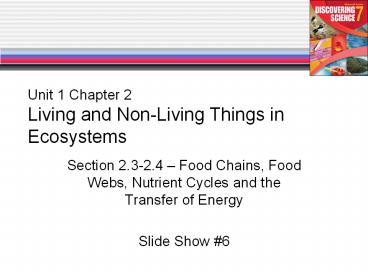Unit 1 Chapter 2 Living and Non-Living Things in Ecosystems - PowerPoint PPT Presentation
1 / 19
Title:
Unit 1 Chapter 2 Living and Non-Living Things in Ecosystems
Description:
Unit 1 Chapter 2 Living and Non-Living Things in Ecosystems Section 2.3-2.4 Food Chains, Food Webs, Nutrient Cycles and the Transfer of Energy – PowerPoint PPT presentation
Number of Views:191
Avg rating:3.0/5.0
Title: Unit 1 Chapter 2 Living and Non-Living Things in Ecosystems
1
Unit 1 Chapter 2Living and Non-Living Things in
Ecosystems
- Section 2.3-2.4 Food Chains, Food Webs,
Nutrient Cycles and the Transfer of Energy - Slide Show 6
2
Producers Consumers (Review)
- Producers
- Green plants, algae, and some micro-organisms
produce their own food through photosynthesis. - Photosynthesis
- Carbon dioxide Water --gt Starch Oxygen
- In words, when plants take in carbon dioxide and
water (in the presence of the sun), they produce
starch (food) and oxygen.
3
Photosynthesis
4
Producers Consumers (Review)
- Consumers
- All organisms that take in food by consuming
other organisms. - There are different levels of consumers
- Primary consumers (only eat producers)
- Secondary consumers (eat producers and/or primary
consumers) - Tertiary consumers (eat producers, primary and/or
secondary consumers)
5
Food Chains
- Food Chains
- The movement of food energy in an ecosystem from
producers through the different levels of
consumers.
- The arrow means is eaten by or goes into.
- The insect is eaten by the frog.
6
Food Chain
7
This is a beach food chainCan you describe what
is happening?
8
Can you show a different food chain?
Label each trophic level include arrows and
decomposers
9
Match the words and phrases.
A food chain shows
producers
Most food chains start with
what is eaten by what
Plants are
predators
Animals are
Animals that hunt and eat others are called
prey
consumers
Animals that are caught and eaten are called
a green plant
10
Food Webs Nutrient Cycle
Food Web
- Food webs
- Two or more intertwining food chains combine to
form a network called a food web. - Nutrient Cycle
- Decomposers are also a part of food chains/webs.
They breakdown dead organisms to put nutrients
back in the soil. - The decomposers are the reason why we never run
out of nutrients.
11
Can you show a different food web?Draw three
food chains and then show inter-linkages
Food Chain 1 Food Chain 2 Food Chain 3
Tertiary Consumers Secondary Consumers Primary
Consumers Producers
12
Food Webs
Check out this cute Food Web game!
http//www.harcourtschool.com/activity/food/food
_menu.html
13
Nutrient Cycles (Review)
- What do producers do to get nutrients?
- How do these nutrients get passed on?
- How do the nutrients get back to the plants?
14
Nutrient Cycles (Cont.)
Draw a and label nutrient cycle for a boreal
forest ecosystem in Newfoundland. Include
producers, primary, secondary and tertiary
consumers, and decomposers.
15
Energy flow
- The energy in any food web initially comes from
the ____. It is converted into food energy by
plants and is then passed on to each level of
consumer. - No new energy is added to the web.
- At each level energy is used up carrying out life
functions. Other energy is lost to the
environment as heat.
16
Energy Pyramid
- At each level in a food web approximately 90 of
the energy gets used up or lost as heat. Leaving
only 10 to be passed on to the next level.
17
Energy Pyramid (cont.)
- Remember
- Energy Pyramids do not always indicate the exact
amount of food energy required, but are simple
generalizations. To model energy flow. Many
factors may influence energy flow
Draw Your Own Energy Pyramid below. Label each
level
18
Energy Pyramid (cont.)
- Energy pyramids usually have no more than four to
five levels. - Why? Complete Activity 2-3B to figure out.
19
Chapter 2 Assign Questions
- Complete the Chapter 2 Assignment Questions for
both Section 2.3 and 2.4!

